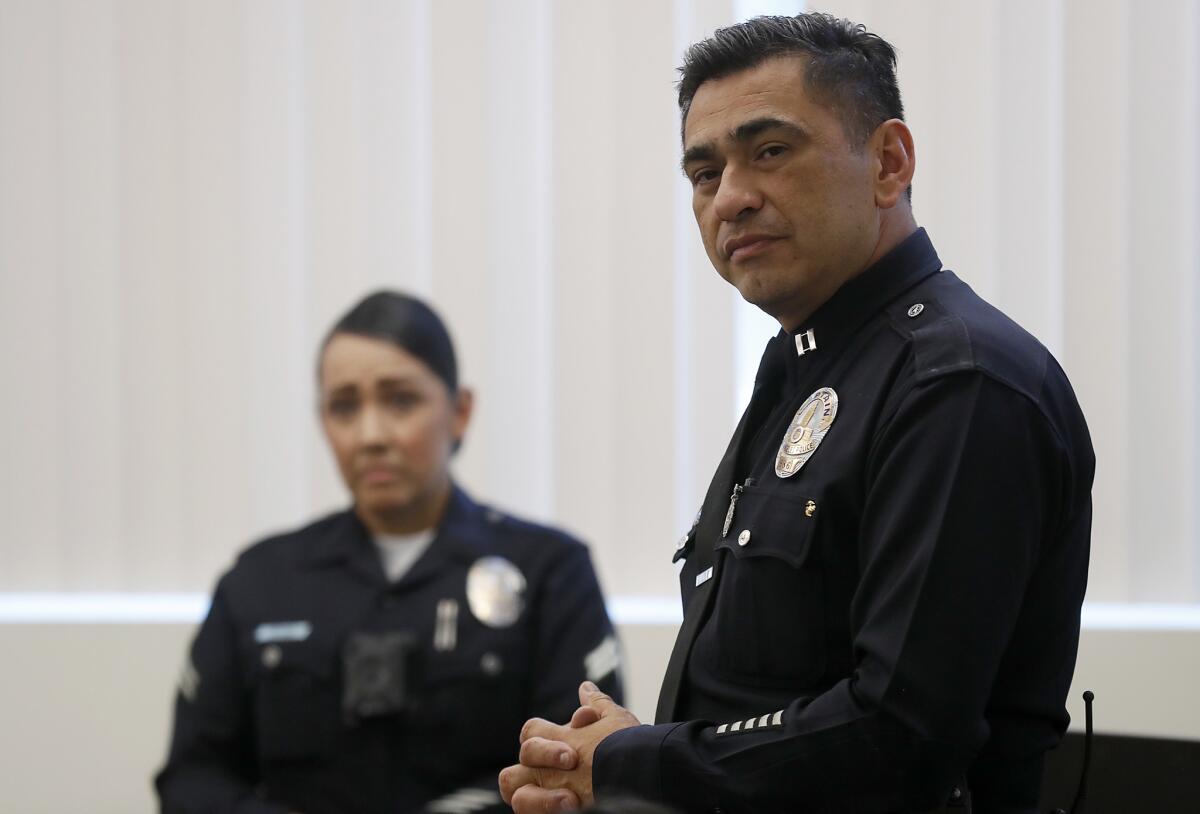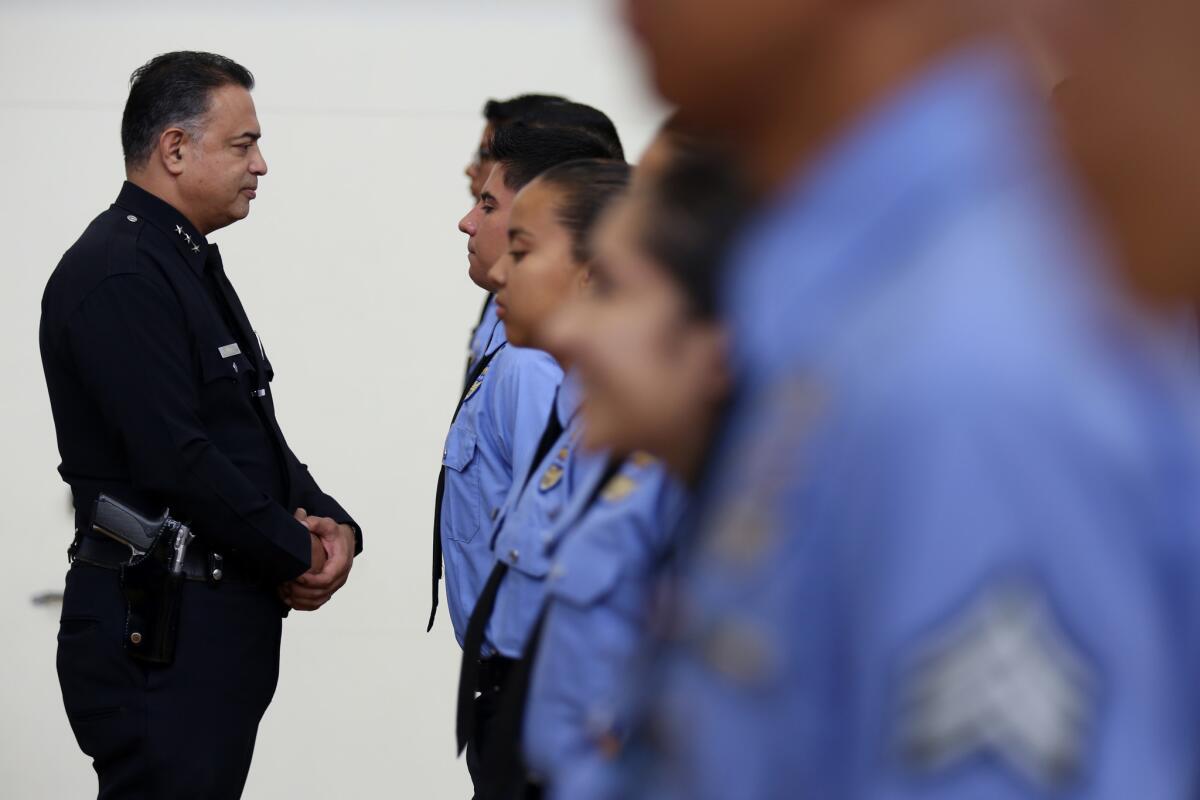In Trump era, LAPD strengthens bonds with immigrants here illegally

- Share via
Al Labrada recalls the terror he felt as a young boy each time he rode from Los Angeles to San Diego on a Greyhound bus and passed through an immigration checkpoint.
Born in Mexico City, he had crossed the border illegally when he was 5 while pretending to be asleep in the back seat of a Ford station wagon.
His experience, the Los Angeles police captain says, serves as a way for him to connect with residents who express fear about being caught up in immigration sweeps. It’s a tale that the 47-year-old, who became an American citizen while serving in the Marine Corps, has shared in one-on-one conversations and at public gatherings.
“I want them to understand that my sympathy and my intent to build trust with the undocumented is more on a personal level, as well as a professional level,” Labrada said after a recent meeting at Santa Teresita Catholic Church, across from a Boyle Heights public housing project.
Connecting with those in the country illegally has emerged as a major goal for the Los Angeles Police Department in the era of President Trump, whose vow to ramp up deportations has stoked fear in immigrant communities.
It’s part of a policing strategy that has actually been employed by the LAPD for decades.
Nearly 40 years ago, the LAPD prohibited officers from questioning residents solely to determine their immigration status, in hopes of fostering trust and cooperation.
In more recent years, a dramatic shift in the department’s demographic makeup has deepened its relationship with the diverse community it serves.
Since the racial unrest of the 1992 riots, the LAPD has created a force that, once almost all white, now nearly mirrors the city: Forty-eight percent of sworn officers are Latino, 10% are Asian and 10% are black. About 15% of the department’s officers are foreign-born.
Though the LAPD remains polarizing — particularly in the black community — on issues of use of force and in-custody deaths, experts say the department has made significant strides in forming a partnership with residents.
“They have not just reformed what they look like and whom they hire, they’ve reformed how they think, they’ve reformed their entire outlook of these communities,” said Connie Rice, a civil rights attorney whose advice has been sought by police commissioners and elected officials for more than three decades. “And they couldn’t have done that with an all-white dominated force — they couldn’t have done that with the old LAPD.”
Robert Arcos, head of the LAPD’s Central Bureau and one of three finalists to be the department’s next chief, said the shift to a diverse police force has been a long time coming.
Growing up in northeast L.A., the deputy chief, a third-generation Mexican American, said the popular 1960s TV show “Adam-12” “was really … what I knew to be LAPD.”
“These two handsome-looking male whites,” Arcos said, referring to fictional officers Pete Malloy and Jim Reed. “When I saw police officers in my neighborhood, it was very typical of watching ‘Adam-12.’ I never really saw anybody who looked like me.”
The transformation of the LAPD created opportunity. But it also created a new set of pressures and expectations.
After Trump took office, the department found itself grappling with a drop in crimes being reported by Latinos. From January to April 2017, there was a decline of more than 23% in sexual assault and a dip of more than 8% in domestic violence incidents reported by Latinos, according to the LAPD.
That prompted officers to hold more than 100 forums to remind people that the department’s stance on supporting the estimated 375,000 Los Angeles residents who are in the country illegally remained the same.
The department issued an 11-page update on immigration procedures in late December, expanding upon its Special Order 40 from 1979 that tells officers not to “initiate police actions with the objective of discovering the alien status of a person.” The notice also expands upon L.A. Mayor Eric Garcetti’s Executive Directive 20 from March 2017, which reaffirmed existing policy around immigration and bars city employees from granting immigration agents access to city facilities that are not expressly open to the general public.
Under the new procedures, police no longer record a place of birth when interviewing victims, witnesses or people who are temporarily detained. Officers still ask anyone who is arrested for their place of birth. That information is taken during fingerprinting and sent to an FBI database, which immigration authorities can access.
The LAPD also has stopped engaging in joint operations with U.S. Immigration and Customs Enforcement or Customs and Border Protection that directly involve civil immigration enforcement. Other cities, including San Gabriel and Santa Cruz, have stopped engaging in joint operations altogether.
And the department no longer transfers people with certain minor criminal convictions to ICE custody. Officers continue to detain and transfer immigrants sought through a judicial warrant or those previously convicted in the United States of a serious or violent felony — a classification that includes more than 60 crimes, including murder, rape, criminal threats, carjacking and arson. Immigrants used to be transferred to ICE custody for aggravated felonies, of which there are hundreds.
In a memo last month to the L.A. Police Commission, the civilian panel that oversees the department, Chief Charlie Beck noted that crime statistics at the end of 2017 showed a “significant improvement” in sexual assault and domestic violence reporting among Latinos.
But immigration activists, in a recent meeting with a City Council committee, said the LAPD’s changes don’t go far enough.
“The order introduced by Chief Beck still allows for information sharing with ICE. It still collects the place of birth information for all those who are arrested, whether they are convicted or not,” said Crissel Rodriguez of the California Immigrant Youth Justice Alliance. “To me, this is unsafe and it further undermines trust between the community and police.”
Beck, however, said police need to comply with the law.
“I think that our order … keeps my obligations as chief of police, but also recognizes that the police draw their most significant authority through the public that they serve,” Beck said in an interview. “And the reality is in Los Angeles that a very strong percentage of that population is undocumented.”
The LAPD plans to submit reports to the Police Commission that detail joint operations, including criminal immigration enforcement, transfers of immigrants to ICE custody and federal requests to interview detainees and be notified of their release.
Ingrid Eagly, an immigration law professor at UCLA, said the LAPD is among a handful of departments leading the way in generating policies that protect immigrant residents.
“We are in a moment of heightened immigration enforcement that is heavily dependent on local police decisions to trigger deportations,” she said. “This makes policing policy — both on the street and inside local jails — an important part of how immigration is actually enforced on the ground.”
The fact that some in the LAPD know what it’s like to be in the country without legal status is an advantage in community outreach.

Jorge Villegas crossed into California illegally as a toddler with his mother and his younger brother in order to join his father. The family ended up in Pico-Union in the 1960s.
His father worked construction during the day and at night in a factory. Villegas’ mother worked as a seamstress, unable to use the architectural degree she had studied for in Guadalajara, Mexico.
“We lived in fear of … la migra,” Villegas said. “I remember not being allowed to be out on the sidewalks or the parks. I had to be picked up from school and made sure that we weren’t seen, so to speak.”
His parents became legal residents in 1970 but did not get their citizenship until the early ’80s.
Villegas enlisted in the Army, where he was able to expedite his citizenship process. Now he is an assistant chief with the LAPD — one of the highest ranks in the 10,000-officer department.
“One of the best ways to provide calm to the community is to say that you are the community,” Villegas said. “When you can genuinely say it, it eases into the opportunity to have meaningful dialogue and to have relationships.”
On a recent evening at the LAPD’s Hollenbeck station in Boyle Heights, Labrada gathered with organizers and other officials for a forum on immigration fraud.
For years, his mother would travel between Mexico and the United States, working to save enough money to bring the family of five to a one-bedroom house in Rosemead in 1975.
While trying to gain residency, his family would wait hours in the cold on Olvera Street — where the Mexican consulate was once located — having an atole, a hot drink made from corn, and churro for breakfast.
“We knew there was a process we had to go through to become legal residents without having that fear of deportation,” said Labrada, who joined the LAPD in 1993.
“I think there’s a lot more anxiety now than when I was a child,” Labrada said, adding that the politics of immigration is not the issue for him. “This is the human side of it, and the human side of it is people are still living in this community and they’re in fear.”
Twitter: @Brittny_Mejia
Twitter: @andreamcastillo
Mather is a former Times staff writer.
More to Read
Sign up for Essential California
The most important California stories and recommendations in your inbox every morning.
You may occasionally receive promotional content from the Los Angeles Times.













